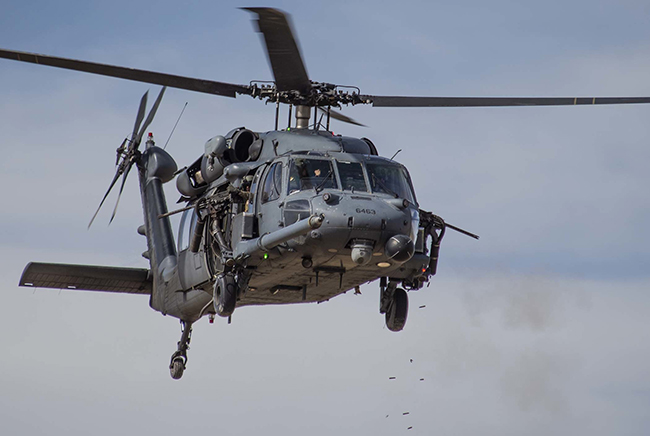
A HH-60G Pave Hawk helicopter assigned to the 66 Rescue Squadron hovers while a Special Missions Aviator fires a .50 caliber machinegun over the Nevada Test and Training Range on May 15, 2019. Air Force photo by A1C Bryan Guthrie.
The Air National Guard should keep some of its HH-60G Pave Hawks around until the new HH-60W Combat Rescue Helicopter comes online because an interim solution is delayed, according to the Senate version of the 2020 defense policy bill.
“Given delays to Operational Loss Replacement program fielding and the on-time fielding of Combat Rescue Helicopter, the Air National Guard should retain additional HH-60G helicopters” to meet fleet inventory recommendations, lawmakers wrote.
As part of the OLR program, the Air Force is reconfiguring 19 Army UH-60L helos as Pave Hawks in order to have 112 HH-60Gs ready for rescue operations. Two test aircraft have been completed. The service previously said it was using 21 UH-60Ls that were supposed to arrive at ANG units in California, Alaska, and New York in fiscal 2018. That schedule has since gotten pushed back.
“During fiscal year 2018, the OLR team resolved two major developmental testing deficiencies, delaying entry into operational testing, and delivered the second developmental testing aircraft,” the Air Force said in its 2018 acquisition report published in April.
The bulk of OLR helicopter deliveries are slated for 2019 and 2020; CRH deliveries are expected to follow in the early 2020s.
Each HH-60G unit—the 210th Rescue Squadron at JB Elmendorf-Richardson, Alaska; the 101st RQS at Gabreski Field, N.Y.; and the 129th RQS at Moffett Federal Airfield, Calif.—owns five primary helicopters. The New York unit has one backup aircraft.
The Air Force outlined the small ANG HH-60G fleet’s training and maintenance demands in a report to the Senate Armed Services Committee last summer, arguing those pilots need an additional three HH-60Gs to meet combat and homeland-security mission requirements.
In the draft 2020 National Defense Authorization Act, SASC asks for a report on the CRH fielding plan no later than 45 days after the bill becomes law. That should describe the differences between the HH-60G, revamped UH-60L, and HH-60W helicopters, which are all built by Sikorsky.
The report must list the costs and risks of changing the CRH delivery plan, include ideas for speeding up the program, and show whether giving Active Duty airmen the CRH first would change when they are deployed and how their capabilities would differ from airmen with OLR helicopters. Lawmakers also want to see the Air Force’s plan to continue training Reserve component HH-60G pilots once all HH-60Ws are delivered.